A company has 100 of credit card sales with a 2 fee and its
A company has $100 of credit card sales with a 2% fee, and its $98 cash is received immediately on deposit. What journal entry does a company make to record the credit card sale if cash is received immediately on deposit?
Debits Accounts Receivable $98, debits Credit Card Expense $2, and credits Sales $100
Debits Cash $98 and credits Accounts Receivable $98
Debits Cash $98, debits Credit Card Expense $2, and credits Sales $100
Debits Cash $100 and credits Sales $100
4.5 points
Question 2
What two methods do companies use to account for uncollectible accounts receivable (bad debts)?
Allowance and direct write-off
Cost and equity
Periodic and perpetual
Gross profit and retail
4.5 points
Question 3
What type of account is Allowance for Doubtful Accounts and what is its normal balance?
Asset with debit balance
Contra asset with credit balance
Expense with debit balance
Revenue with credit balance
4.5 points
Question 4
What journal entry does a company make to write off a customer\'s uncollectible account under the direct write-off method?
Debits Allowance for Doubtful Accounts and credits Accounts Receivable
Debits Allowance for Doubtful Accounts and credits Bad Debts Expense
Debits Bad Debts Expense and credits Accounts Receivable
Debits Bad Debts Expense and credits Allowance for Doubtful Accounts
4.5 points
Question 5
What adjusting entry does a company make to record estimated bad debts under the allowance method?
Debits Allowance for Doubtful Accounts and credits Accounts Receivable
Debits Allowance for Doubtful Accounts and credits Bad Debts Expense
Debits Bad Debts Expense and credits Accounts Receivable
Debits Bad Debts Expense and credits Allowance for Doubtful Accounts
4.5 points
Question 6
What journal entry does a company make to write off a customer\'s uncollectible account under the allowance method?
Debits Allowance for Doubtful Accounts and credits Accounts Receivable
Debits Allowance for Doubtful Accounts and credits Bad Debts Expense
Debits Bad Debts Expense and credits Accounts Receivable
Debits Bad Debts Expense and credits Allowance for Doubtful Accounts
4.5 points
Question 7
Allowance for Doubtful Accounts has a $700 debit balance before adjustment at year-end. Net sales are $200,000, and bad debts expense is estimated at 1% of net sales. Using percent of sales method, compute estimated bad debts amount to be used in year-end adjusting entry.
$700
$1,300
$2,000
$2,700
4.5 points
Question 8
Allowance for Doubtful Accounts has a credit balance of $1,100 before adjustment at year-end. An aging analysis of accounts receivables indicates uncollectible accounts of $12,900. Using aging of receivables method, compute estimated bad debts amount to be used in year-end adjusting entry.
$1,100
$11,800
$12,900
$14,000
4.5 points
Question 9
A company receives a $10,000, 12%, 60-day note, dated June 15, from a customer to apply on account. Compute the maturity value of the note. (Use a 360-day year.)
$ 9,800
$10,000
$10,200
$11,200
4.5 points
Question 10
What journal entry does a company make to record the collection of an interest-bearing note received and collected in the same accounting period?
Debits Cash, credits Notes Payable, and credits Interest Expense
Debits Cash, credits Notes Receivable, and credits Interest Revenue
Debits Notes Payable, debits Interest Expense, and credits Cash
Debits Notes Receivable, debits Interest Revenue, and credits Cash
4.5 points
Question 11
Which of the following is a characteristic of plant assets? They
Are also called intangible assets
Are held for sale and not used in operations
Are tangible assets used in operations
Have a useful life of less than one year
4.5 points
Question 12
Equipment with a cost of $65,000 has an estimated salvage value of $5,000 and an estimated life of 5 years or 15,000 hours. What is the amount of depreciation for the first full year, assuming the company uses the straight-line method?
$8,000
$12,000
$24,000
$26,000
4.5 points
Question 13
$8,000
$12,000
$24,000
$26,000
4.5 points
Question 14
Equipment with a cost of $65,000 has an estimated salvage value of $5,000 and an estimated life of 5 years or 15,000 hours. What is the amount of depreciation for the first full year, assuming the company uses the double declining-balance method?
$8,000
$12,000
$24,000
$26,000
4.5 points
Question 15
Equipment with a cost of $25,000 and accumulated depreciation of $22,500 is sold for $3,500. What amount of gain or loss does the company recognize and record on the sale of the equipment?
$1,000 loss
$1,000 gain
$2,500 loss
$2,500 gain
4.5 points
Question 16
What adjusting entry does a company make to record depreciation of equipment?
Debits Depreciation Expense and credits Equipment
Debits Depreciation Expense and credits Accumulated Depreciation
Debits Accumulated Depreciation and credits Depreciation Expense
Debits Equipment and credits Accumulated Depreciation
4.5 points
Question 17
At what amounts are plant assets ordinarily reported on the balance sheet?
Current market values
Replacement costs
Cost less accumulated depreciation
Lower of cost of market
4.5 points
Question 18
What is the using up of natural resources called?
Allocation
Amortization
Depletion
Depreciation
4.5 points
Question 19
What journal entry does a company make to record the using up of natural resources?
Debits Accumulated Depreciation and credits Amortization Expense
Debits Amortization Expense and credits Accumulated Amortization
Debits Depletion Expense and credits Accumulated Depletion
Debits Depreciation Expense and credits Accumulated Depreciation
4.5 points
Question 20
What is the using up of intangible assets called?
Allocation
Amortization
Depletion
Depreciation
4.5 points
Question 21
Obligations due to be paid within one year or the company\'s operating cycle, whichever is longer, are reported as
Current assets
Current liabilities
Long-term assets
Long-term liabilities
4.5 points
Question 22
Our company needs money for a project and decides to borrow it from a bank. What journal entry does our company make to record the promissory note given to the bank to borrow this money?
Debits Accounts Payable and credits Cash
Debits Accounts Payable and credits Notes Payable
Debits Cash and credits Notes Payable
Debits Notes Payable and credits Cash
4.5 points
Question 23
A company borrows $10,000 from First Bank on March 1 by signing a $10,000, 6%, 30-day interest-bearing note. What journal entry does the company record when it pays the note on March 31, assuming no previous accrual of interest?
Debits Accounts Payable $10,000; debits Interest Expense $50; and credits Notes Payable $10,050
Debits Cash $10,050; credits Notes Receivable $10,000; and credits Interest Revenue $50
Debits Notes Payable $10,050 and credits Cash $10,050
Debits Notes Payable $10,000; debits Interest Expense $50; and credits Cash $10,050
4.5 points
Question 24
An employer has one employee who earned $2,000 the first month of employment. The FICA tax rate for Social Security is 6.2% and the FICA tax rate for Medicare is 1.45%. The employee has $213 in federal income taxes withheld and voluntary monthly deductions of $85 for health insurance and $25 for union dues. Calculate the employee\'s net pay for the first month.
$1,524
$1,677
$1,847
$2,000
4.5 points
Question 25
An employer has one employee who earned $2,000 his first month of employment. The FICA tax rate for Social Security is 6.2% and the FICA tax rate for Medicare is 1.45%. The employer\'s FUTA tax rate is 0.8% and the SUTA tax rate is 5.4%. Calculate the employer\'s payroll tax expense for the first month.
$124
$153
$277
$446
4.5 points
Question 26
What journal entry does a company make to record the accrued payroll expenses and liabilities for its employees?
Debits Cash for gross pay, debits payroll deductions to liability accounts, and credits Salaries Payable for net pay
Debits Salaries Expense for gross pay, credits payroll deductions to liability accounts, and credits Salaries Payable for net pay
Debits Salaries Expense for gross pay, credits payroll deductions to liability accounts, and credits Cash for net pay
Debits Salaries Payable for gross pay, debits payroll deductions to expense accounts, and credits Salaries Expense for net pay
4.5 points
Question 27
What journal entry does a company make to pay the payroll (net pay to employees)?
Debits Cash and credits Salaries Payable
Debits Salaries Expense and credits Cash
Debits Salaries Expense and credits Salaries Payable
Debits Salary Payable and credits Cash
4.5 points
Question 28
An employer\'s payroll taxes are as follows: FICA—Social Security of $124, FICA—Medicare of $29, State Unemployment Taxes of $108, and Federal Unemployment Taxes of $16. What journal entry does a company make to record the employer\'s payroll taxes?
Debits FICA—Social Security Taxes Payable for $124, debits FICA—Medicare Taxes Payable for $29, debits State Unemployment Taxes Payable for $108, debits Federal Unemployment Taxes Payable for $16, and credits Payroll Taxes Expense for $277
Debits Payroll Taxes Expense for $277, credits FICA—Social Security Taxes Payable for $124, credits FICA—Medicare Taxes Payable for $29, credits State Unemployment Taxes Payable for $108, and credits Federal Unemployment Taxes Payable for $16
Debits Payroll Taxes Expense for $277 an credits Cash for $277
Debits Taxes Payable for $277 and credits Payroll Taxes Expense for $277
4.5 points
Question 29
What journal entry does a company make to record estimated warranty expense at year-end?
Debits Estimated Warranty Liability and credits Cash
Debits Estimated Warranty Liability and credits Warranty Expense
Debits Warranty Expense and credits Cash
Debits Warranty Expense and credits Estimated Warranty Liability
4.5 points
Question 30
Which of the following is an advantage of bond financing?
Interest paid on bonds is tax deductible.
Bonds require payment of both periodic interest and par value at maturity.
Bonds can decrease return on equity.
Bonds affect owner control.
| Debits Accounts Receivable $98, debits Credit Card Expense $2, and credits Sales $100 | ||
| Debits Cash $98 and credits Accounts Receivable $98 | ||
| Debits Cash $98, debits Credit Card Expense $2, and credits Sales $100 | ||
| Debits Cash $100 and credits Sales $100 |
Solution
1) Debits Cash $98, debits Credit Card Expense $2, and credits Sales $100
2) Allowance and direct write-off
3) Asset with debit balance
4) Debits Bad Debts Expense and credits Accounts Receivable
5) Debits Allowance for Doubtful Accounts and credits Accounts Receivable
6) Debits Bad Debts Expense and credits Allowance for Doubtful Accounts
7) $2,700
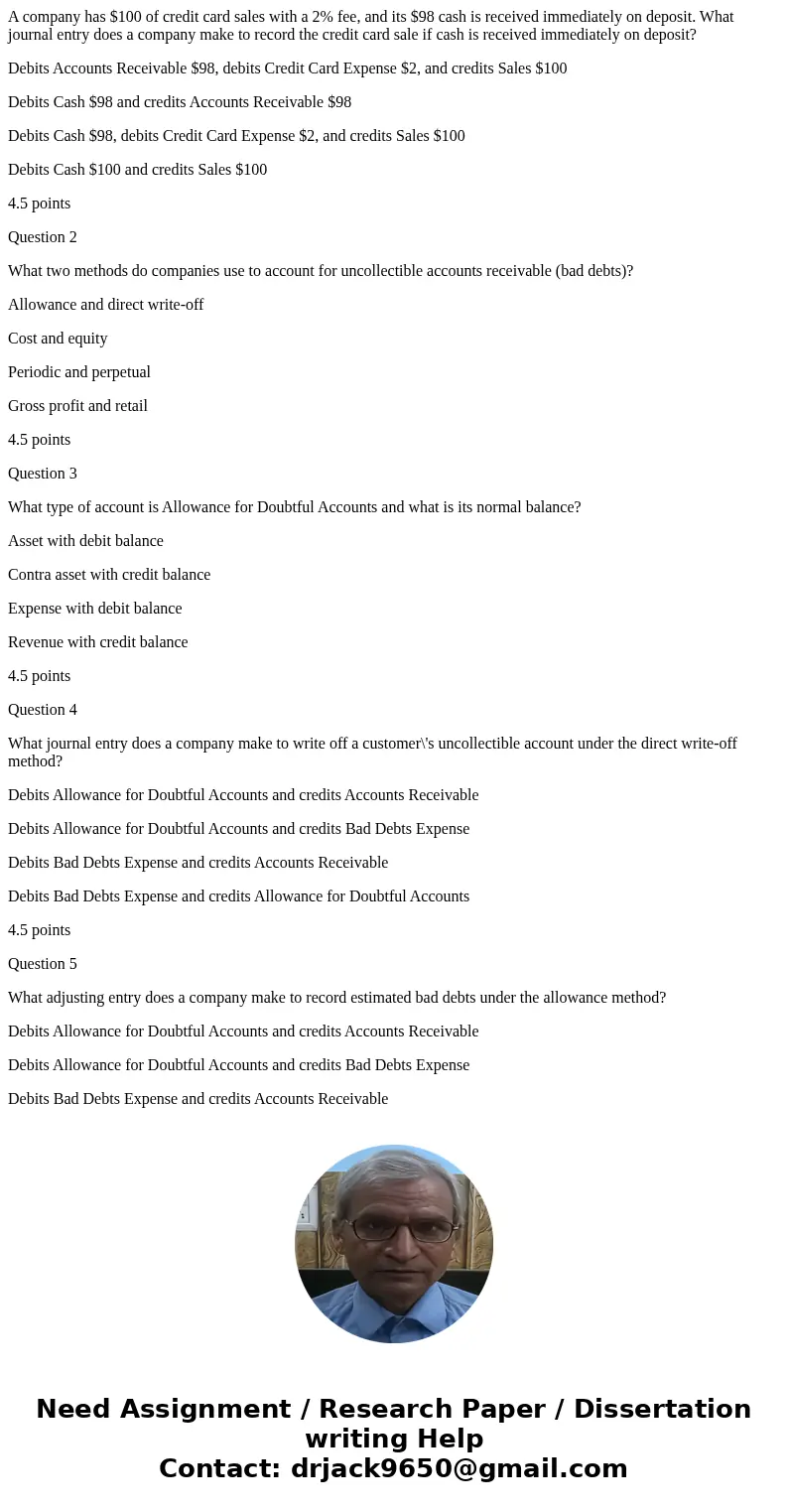
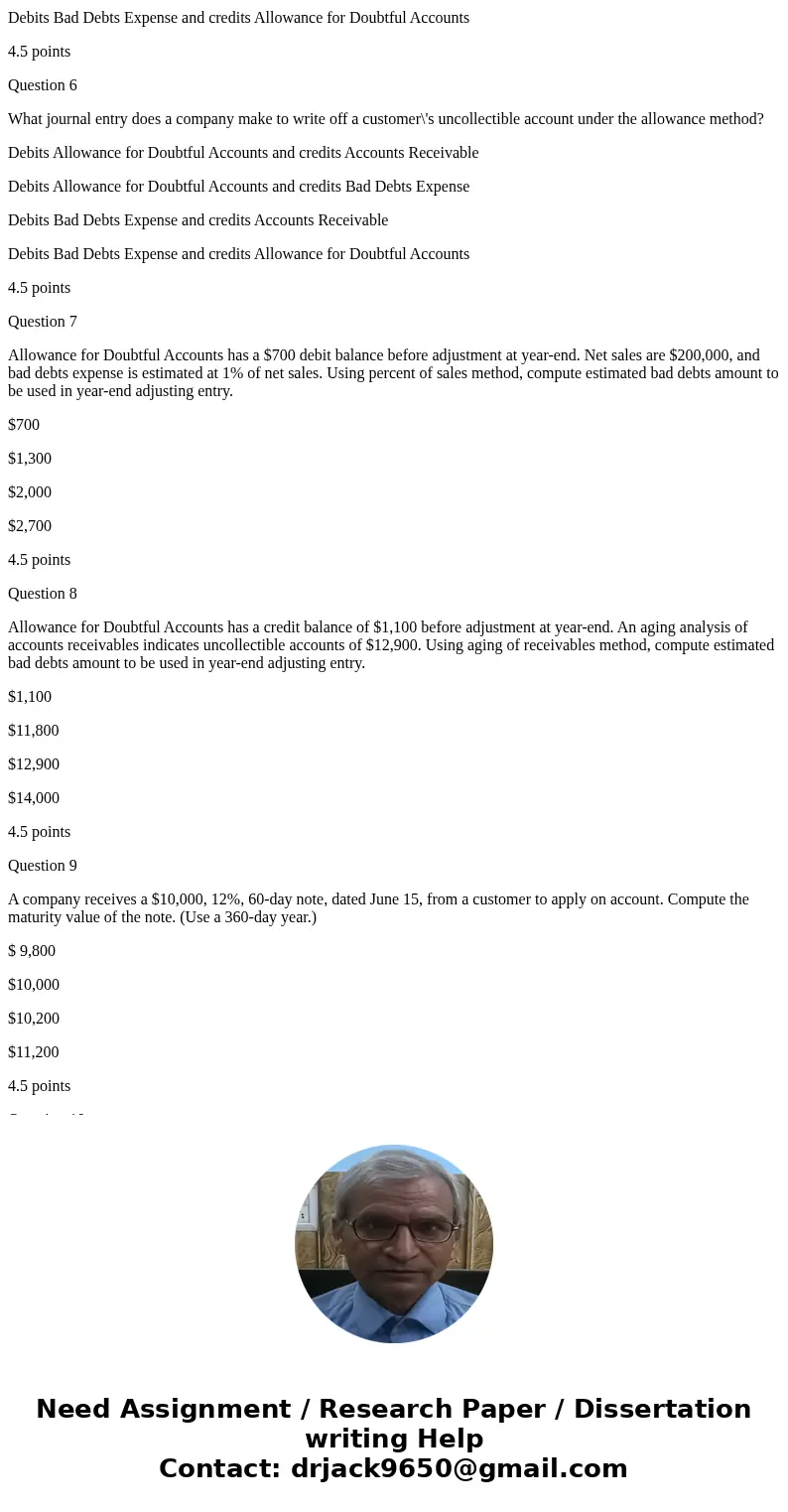
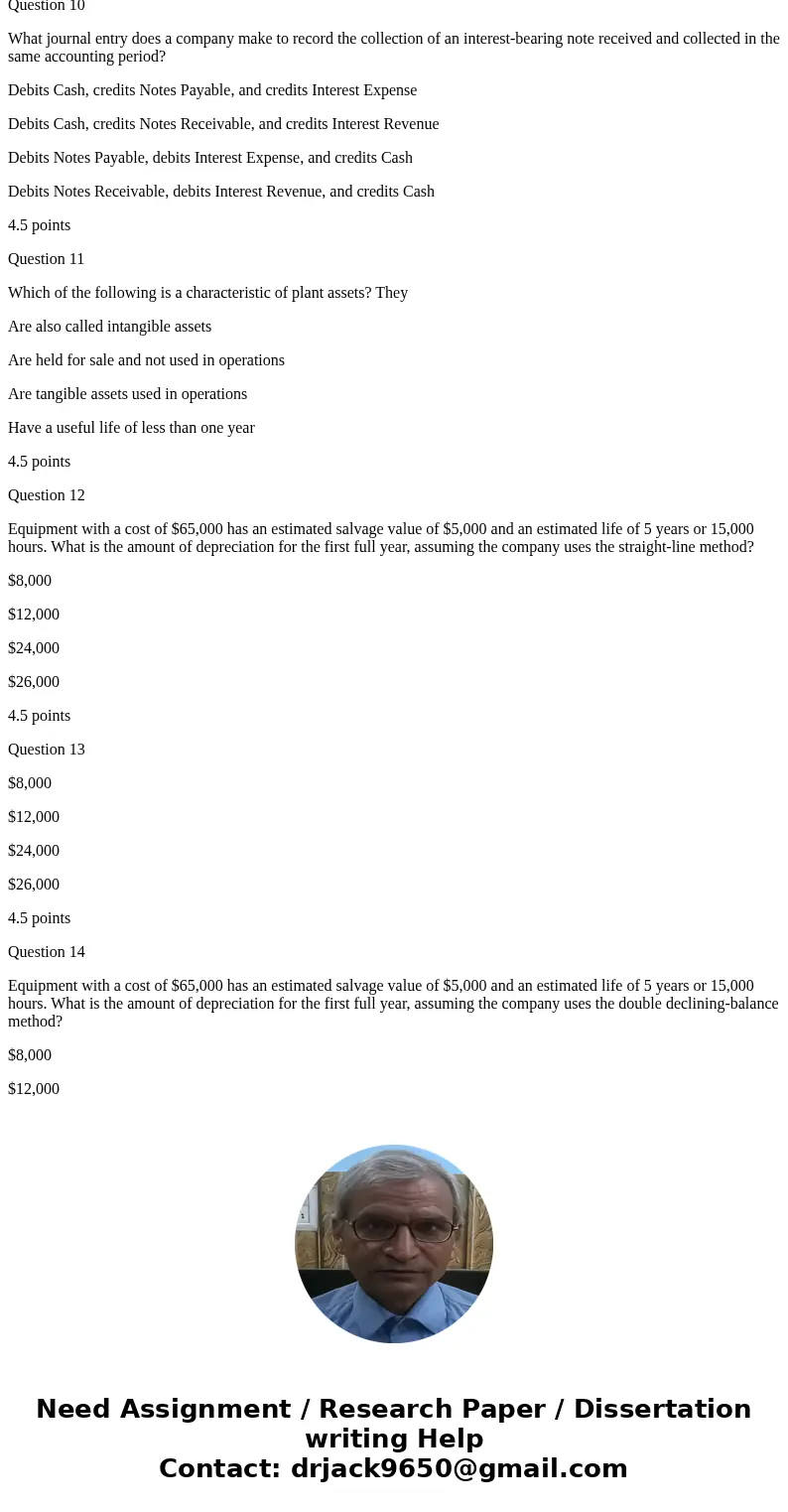
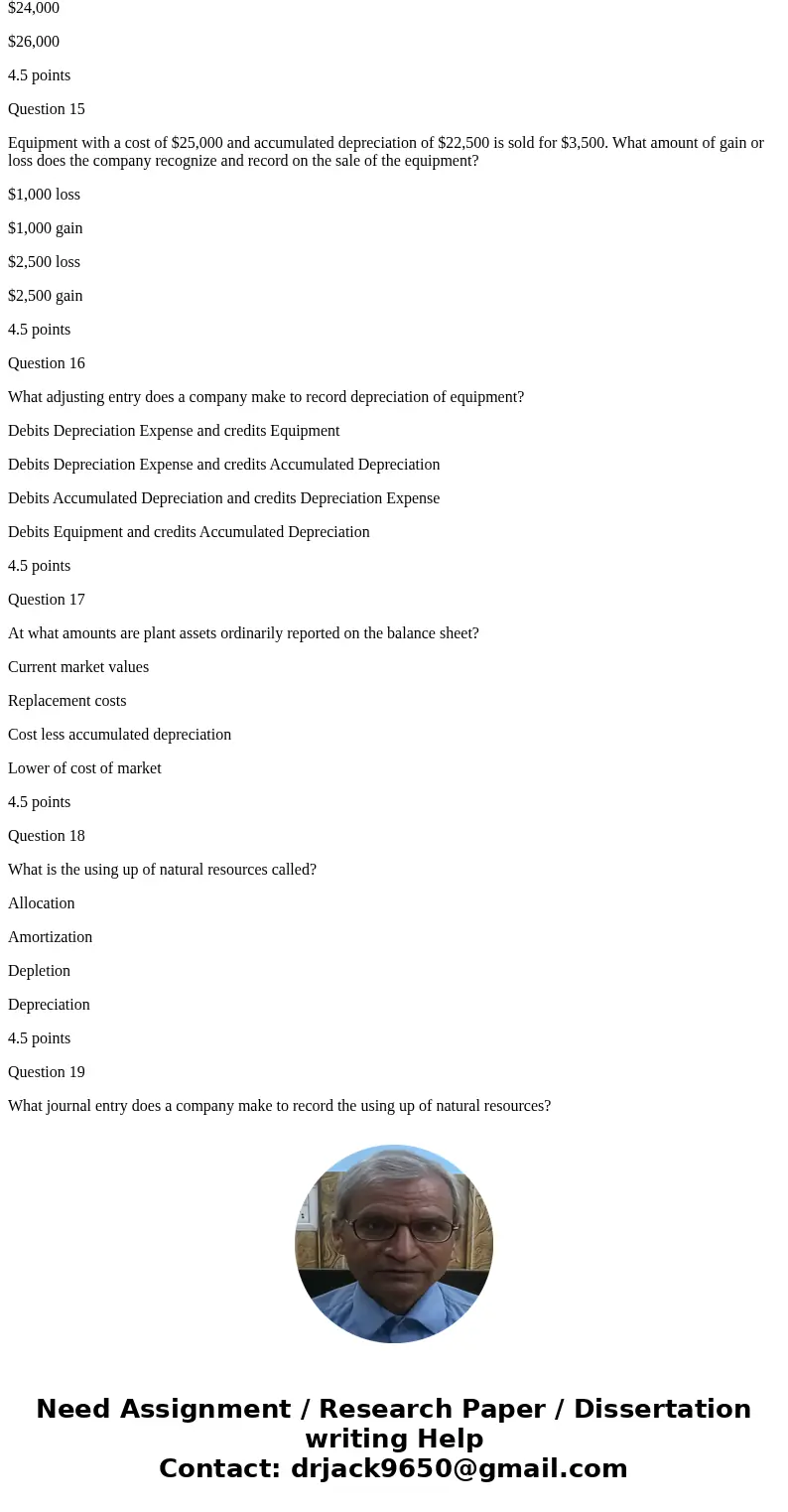
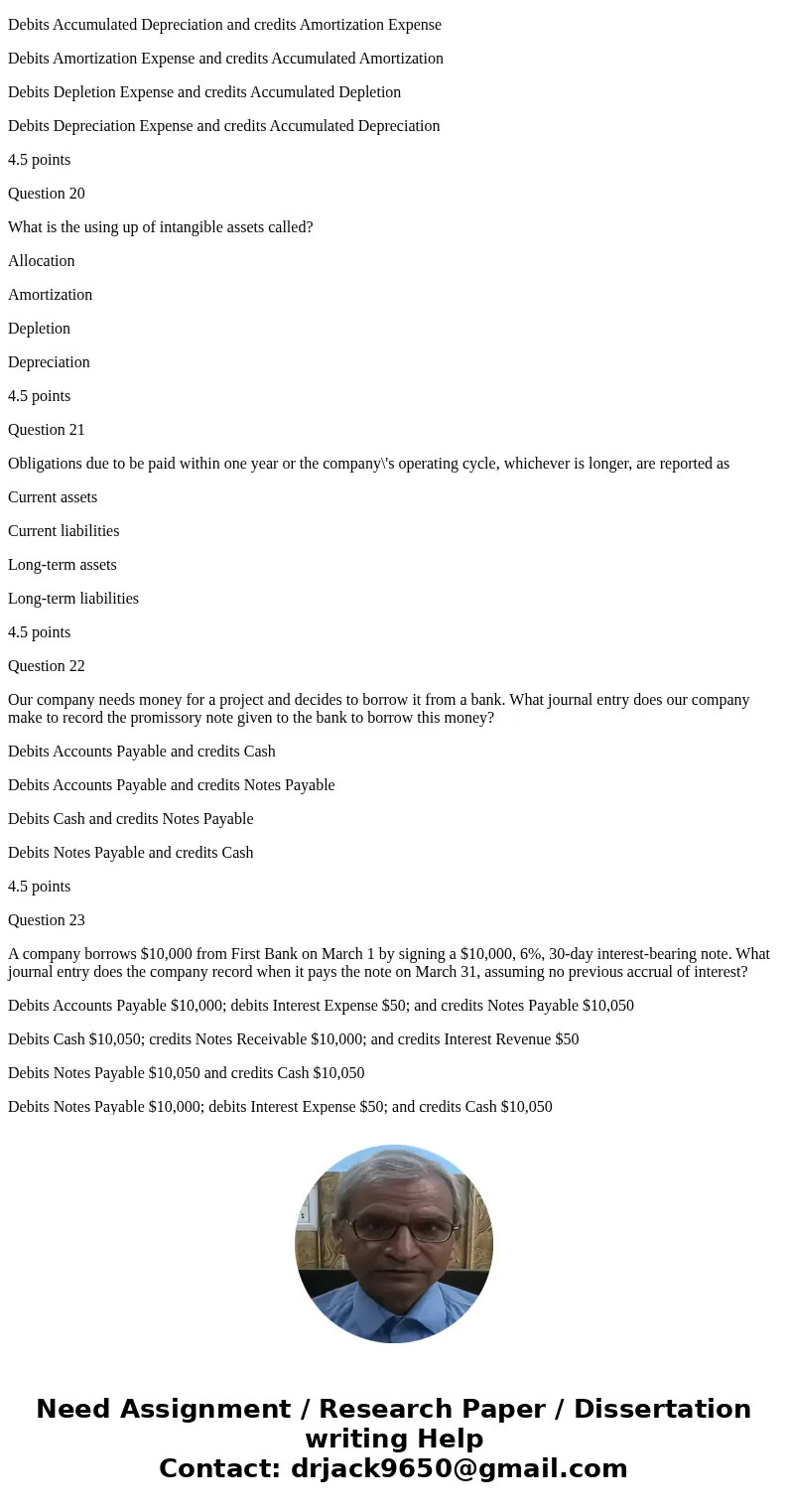
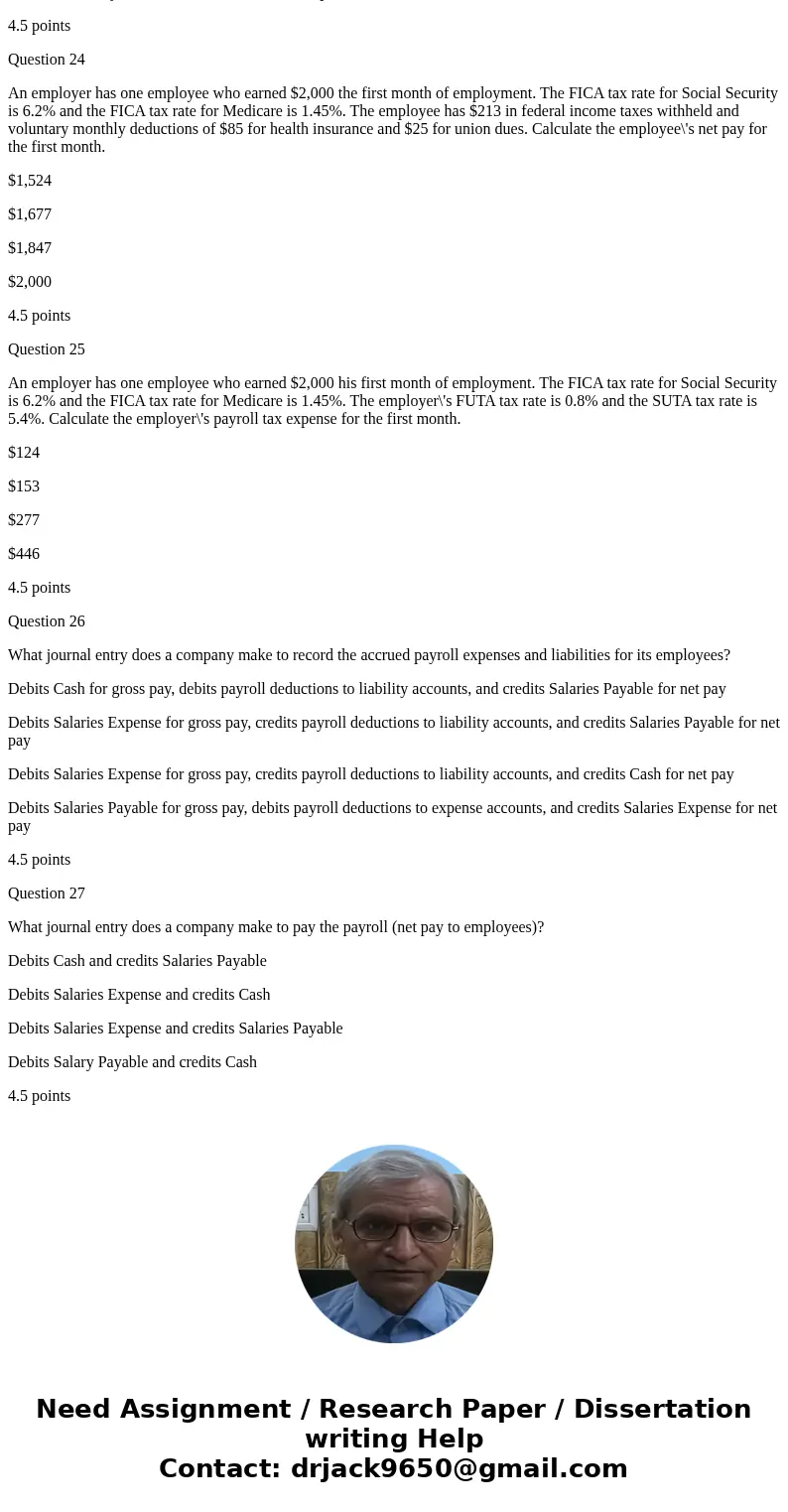
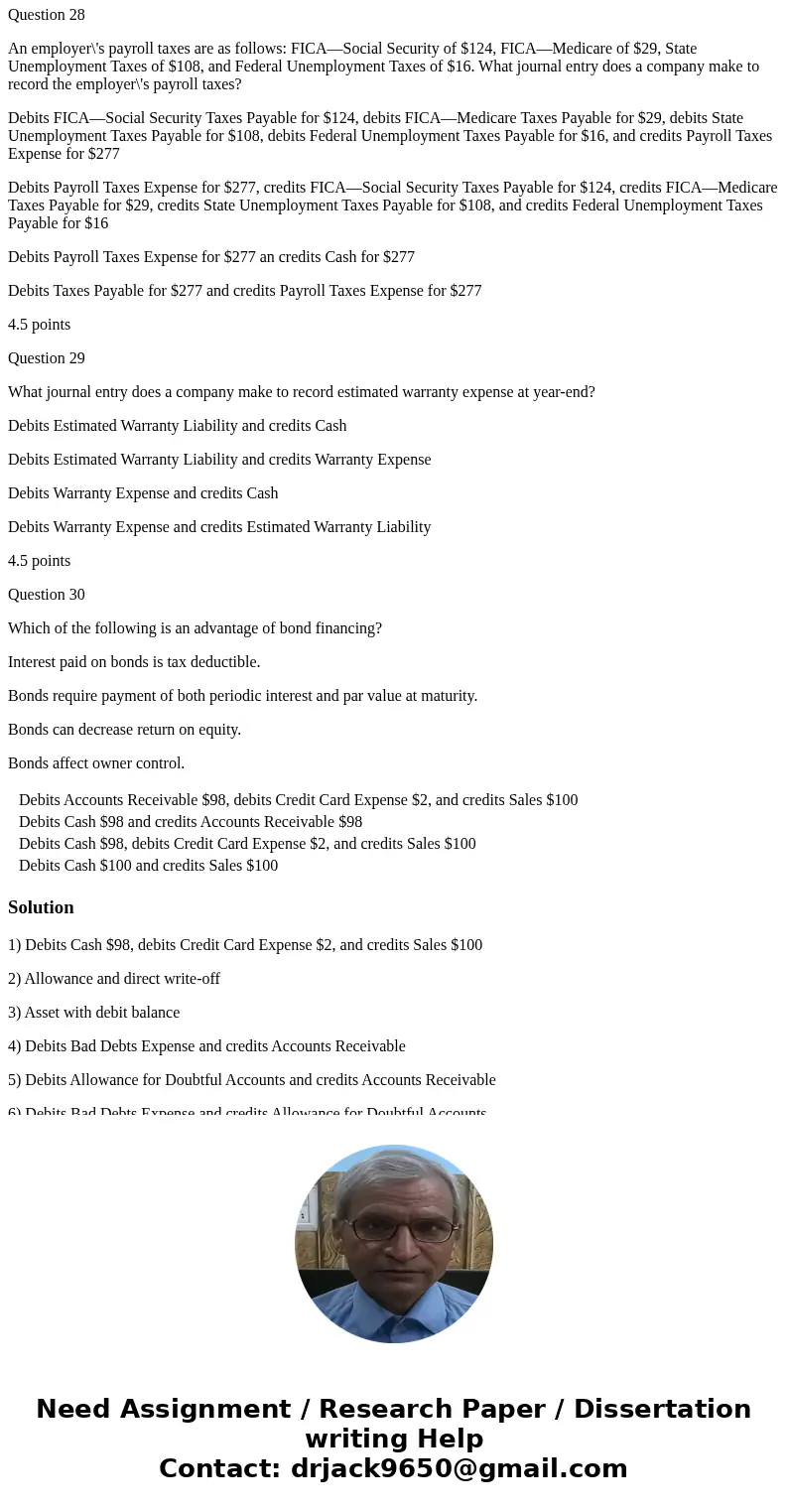
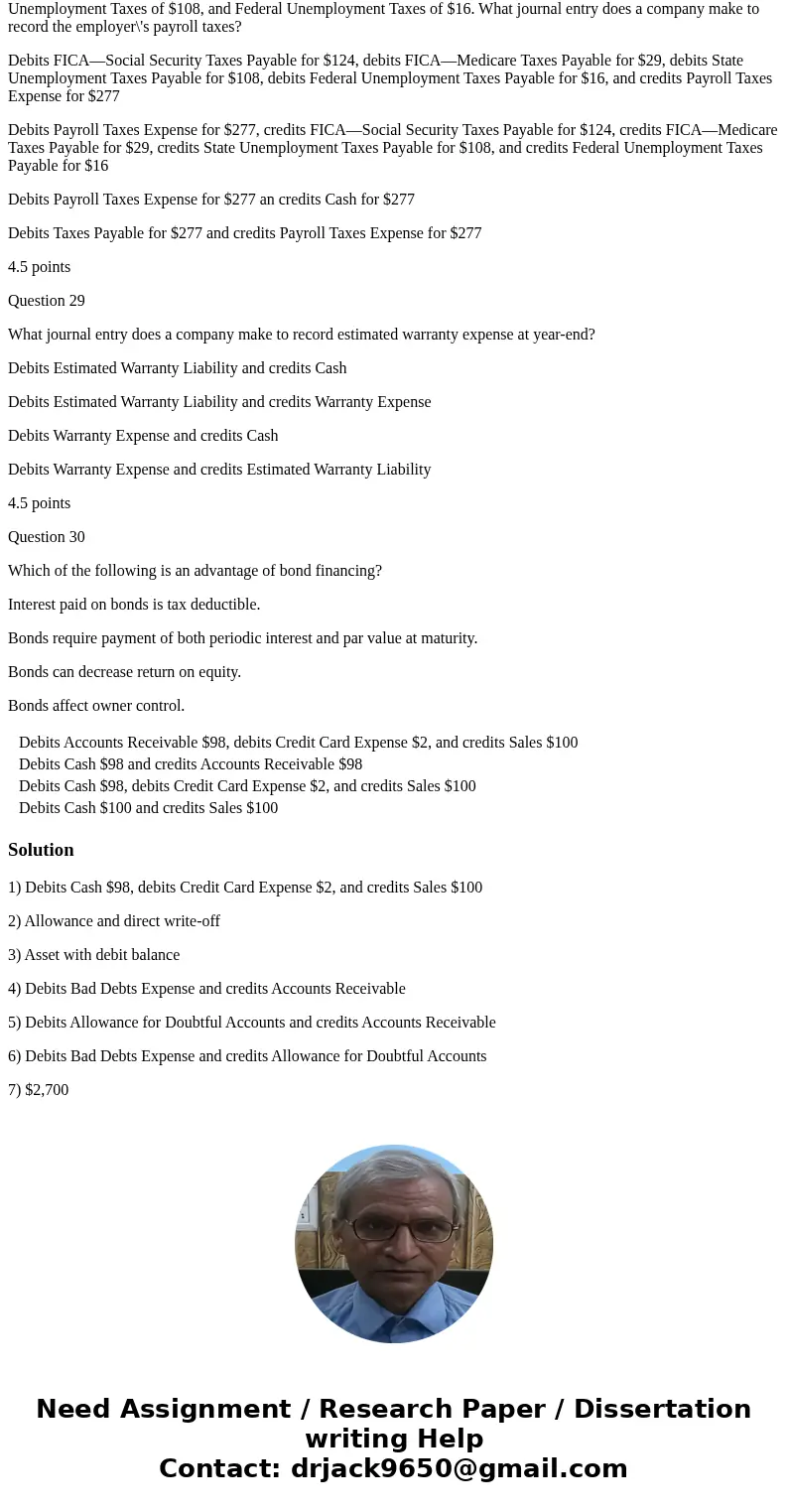
 Homework Sourse
Homework Sourse